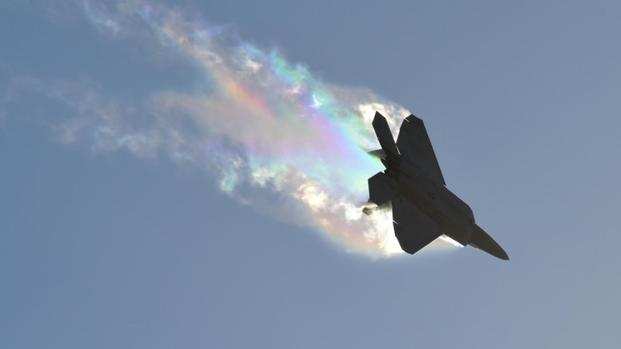Three years ago, the F-22 Raptor made its combat debut in Syria.
The idea was for the fifth-generation fighter to use its stealth technology to evade detection from surface-to-air missile batteries in a contested region. But the Syrians apparently had no plans to fire on U.S. aircraft, at least before the Russians entered the battlespace. So the twin-engine aircraft designed primarily for air-to-air superiority took on a different role in the fight: serve as a high-altitude reconnaissance platform and major airborne command post.
Similarly, when the Raptor made its combat debut on Sunday in Afghanistan, the jet conducted a ground-attack mission, pummelling suspected drug labs in the country with small diameter bombs, Air Force officials said.
While some observers criticized the mission as overkill and a waste of resources, officials inside and outside of the Air Force said it served a purpose by employing particular munitions designed to minimize collateral damage and by offering realistic training to learn more about how the weapon system performs in combat scenarios.
Related:
- Air Force's Monthly Bombing Campaign in Afghanistan Hits 5-Year High
- Why the F-22 Raptor Didn't Get the Air-to-Air Kill in Syria
- Did the Air Force Dash Hopes for Building More F-22s?
"We opted to use the F-22 for this operation because of its ability to carry the small diameter bomb that was necessary to keep collateral damage to an absolute minimum, and because the SDBs needed for the operation were located there with the aircraft," Lt. Col Damien Pickart, spokesman for Air Forces Central Command, said in response to an email from Military.com.
At the onset, the decision to use the Raptor seemed puzzling, as the Taliban and militants in region do not have the sophisticated weaponry the aircraft was built to dodge.
The F-22s were joined by B-52 Stratofortresses and Afghan A-29 Super Tucanos to conduct an expanded strike mission -- called the new offensive campaign -- against the Taliban's revenue stream, said Army Gen. John Nicholson, commander of the NATO-led Resolute Support mission and U.S. Forces Afghanistan.
When asked about the strike, Nicholson said the Raptor was employed "because of its ability to deliver precision munitions."
Realistic Training
But it's not just about the weapons they employ -- it's also extra practice for pilots, according to at least one defense analyst in Washington, D.C.
"We're using F-22s in Afghanistan for the same reason the Russians are using their latest bombers and ships and missiles in Syria: Realistic training," the source told Military.com on background. "We both have a generation of weapons that we haven't used in combat, and the more we can learn about how they actually work as opposed to how they work on our test ranges, the better equipped will be for when it's not a permissive fight."
When the U.S. is fighting a war, the analyst added, "it's not about choosing the cheapest weapon -- it's about using the one that will get there when you need it with what you need aboard."
Granted, the military has a number of aircraft -- the F/A-18E/F and F-15E Strike Eagle -- that can drop the GBU-39 Small Diameter Bomb, a precision-guided glide bomb developed by Boeing Co.
"But if [U.S. Central Command] is to be believed, many of them were busy elsewhere," the source said. "To a commander, it's silly to have a usable asset and not use it just because you think it may be overqualified."
Refueling Support
F-22s began the mission, Pickart said, and F-16 Fighting Falcons continued the operation as the bombing runs kept rolling.
Refueling tankers -- including KC-135 Stratotankers from Al Udeid Air Base, Qatar, and KC-10 Extenders from Al Dhafra Air Base, United Arab Emirates -- provided refueling support for the Raptors.
"These aircraft were used to refuel aircraft coming from both locations, as well as fuel other aircraft operating in the theater during" the strikes, between Nov. 19 and 20, Pickart said.
The command used tankers in Afghanistan for the F-16s to distribute support, he said.
"The KC-135s based out of Kandahar, [Afghanistan], provided refueling support for F-16s conducting routine close air support and strike missions that continued in Afghanistan while this new offensive was underway," the spokesman said.
He added, that throughout the night between Nov. 20 and 21, the Air Force conducted "additional strikes on narcotic facilities using F-16s based out of Bagram and they were supported by the Kandahar-based KC-135s."
More Airstrikes
The F-22s launched from Al Dhafra, where the planes reside for operations in the Middle East. The Raptors are part of the 95th Expeditionary Fighter Squadron out of Tyndall Air Force Base, Florida. Whether commanders will use the Raptors again for another mission in the country remains to be seen.
Earlier this year, the military dropped the most powerful conventional bomb in the U.S. arsenal -- the 21,600-pound GBU-43 Massive Ordnance Air Blast (MOAB) nicknamed "mother of all bombs" -- in Afghanistan in the first-ever use of the munition in combat. But the MOAB hasn't made a comeback -- yet.
Meantime, the number of strikes from F-16s and MQ-9 Reaper aircraft in the country are on the rise. The Air Force dropped more than 900 weapons in August and September combined, up from 270 for the same timeframe last year, according to AFCENT's latest airpower summary.
"We've used airpower -- dropped more munitions this year than any year since 2012," Nicholson said on Monday. "We did this because the Afghans were on the offensive more. And so we were able to get out there in a pre-planned manner, bringing in assets to assist, to deliver a lot of munitions."
He added, "We've been very robust in our use of airpower in support of the Afghans on the offensive this year."










